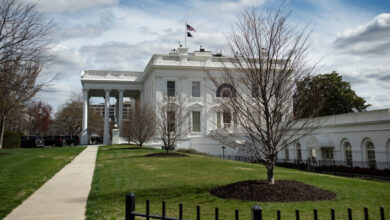What Fed Rate Moves Mean for Mortgages, Credit Cards and Student Loans

American households who have been hoping interest rates would soon decline may have to wait a bit longer.
The Federal Reserve is expected to keep its benchmark interest rate unchanged on Wednesday. But yet another report of persistent inflation may ultimately cause the policy-making body to keep rates elevated for longer than it had previously expected.
The central bank has raised its key interest rate to 5.33 percent from near zero in a series of increases between March 2022 and last summer, and they’ve remained unchanged since then. The goal was to tamp down inflation, which has cooled considerably, but is still higher than the Fed would like.
For people with money stashed away in higher-yielding savings accounts, a continuation of elevated rates translates into more interest earnings. But for people saddled with high cost credit card debt, or aspiring homeowners who have been sidelined by higher interest rates, a lower-rate environment can’t come soon enough.
“U.S. consumers should be prepared to continue to face relatively high interest rates across a range of credit products for a while longer, with any potential rate decreases likely being pushed to later in 2024,” said Michele Raneri, vice president of U.S. research and consulting at TransUnion, one of the nation’s three largest consumer credit companies.
Here’s how different rates are affected by the Fed’s decisions — and where they stand.
Credit Cards
Credit card rates are closely linked to the central bank’s actions, which means that consumers with revolving debt have seen those rates quickly rise over the past couple of years. Increases usually occur within one or two billing cycles, but don’t expect them to fall quite as rapidly even when rates eventually decline.
“The urgency to pay down high-cost credit card or other debt is not diminished,” said Greg McBride, chief financial analyst at Bankrate. “Interest rates took the elevator going up, but they’re going to take the stairs coming down.”
That means that consumers should prioritize repayment of higher-cost debt and take advantage of zero-percent and low-rate balance transfer offers when they can.
The average rate on credit cards with assessed interest was 22.63 percent at the end of March, according to the Federal Reserve, compared with 20.92 percent a year earlier and 16.17 percent at the end of March 2022, when the Fed began its series of rate increases.
Car Loans
Auto loan rates remain elevated, which, coupled with higher car prices, continues to squeeze affordability. But if interest rates won’t budge, then automakers and dealerships may have to find ways to incentivize buyers to stoke demand.
“As signs indicate that the Fed isn’t ready to cut rates just yet, the burden will shift to automakers to further subsidize interest rates and offer incentives if they want to sustain new vehicle sales,” said Joseph Yoon, a consumer insights analyst at Edmunds, an automotive research firm.
“In the used market, dealerships will have to decide if they are comfortable holding onto inventory longer or adjusting pricing down to meet consumers’ financial situations,” he added.
The average rate on new-car loans was 7.2 percent in March, according to Edmunds, up from 7 percent last March and 4.5 percent in the same month of 2022. Used-car rates were even higher: The average loan carried an 11.9 percent rate in March, up from 11.4 percent in the same month in 2023 and 8.1 percent in 2022.
Car loans tend to track with the yield on the five-year Treasury note, which is influenced by the Fed’s key rate — but that’s not the only factor that determines how much you’ll pay. A borrower’s credit history, the type of vehicle, the loan term and the down payment are all baked into that rate calculation.
Mortgages
Mortgage rates have again been on the rise, with the most popular loan crossing the 7 percent mark in recent weeks, making homeownership an even costlier proposition.
The average 30-year mortgage rate was 7.17 percent as of April 25, according to Freddie Mac, compared with 6.43 percent in the same week last year.
It’s been a volatile ride. Rates climbed as high as 7.79 percent in late October before dropping about a point lower and stabilizing — at least temporarily.
“Going forward, mortgage rates will likely continue to fluctuate,” said Jacob Channel, senior economist at LendingTree, “and it’s impossible to say for certain where they’ll end up.”
Rates on 30-year fixed-rate mortgages don’t move in tandem with the Fed’s benchmark, but instead generally track with the yield on 10-year Treasury bonds, which are influenced by a variety of factors, including expectations about inflation, the Fed’s actions and how investors react.
Other home loans are more closely tethered to the central bank’s decisions. Home-equity lines of credit and adjustable-rate mortgages — which each carry variable interest rates — generally rise within two billing cycles after a change in the Fed’s rates. The average rate on a home-equity loan was 8.63 percent as of April 24, according to Bankrate, while the average home-equity line of credit was 9.10 percent.
Student Loans
Borrowers who hold federal student loans are not affected by the Fed’s actions because such debt carries a fixed rate set by the government.
But batches of new federal student loans are priced each July based on the 10-year Treasury bond auction in May. And those loan rates have climbed: Borrowers with federal undergraduate loans disbursed after July 1 (and before the upcoming July 1) will pay 5.5 percent, up from 4.99 percent for loans disbursed in the same period a year before. Just three years ago, rates were below 3 percent.
Graduate students taking out federal loans will also pay about half a point more than the rate from a year earlier, or about 7.05 percent on average, as will parents, at 8.05 percent on average.
Borrowers of private student loans have already seen rates climb because of previous rate increases: Both fixed- and variable-rate loans are linked to benchmarks that track the federal funds rate, the Fed’s benchmark rate.
Savings Vehicles
Savers tend to benefit when the federal funds rate is higher because many banks will pay more on their savings accounts — particularly if they want to attract more deposits. (Many banks earn money on the difference between their cost of funds, like deposits, and the interest rate they charge on loans.)
And online institutions tend to price their online savings accounts much more competitively than their brick-and-mortar counterparts.
Even though the Fed’s benchmark rate has remained unchanged, several online banks have begun to dial back the rates they pay to consumers because they expect the Fed to cut rates at some point this year. Certificates of deposit, which tend to track similarly dated Treasury securities, have already seen their rates drop multiple times this year.
The average one-year C.D. at online banks was 4.94 percent as of April 1, down from its peak yield of 5.35 percent in January, but up from 4.72 percent a year earlier, according to DepositAccounts.com. But you can still find one-year C.D.s with yields of more than 5 percent.
Most online banks have held their savings account rates relatively steady: The average yield on an online savings account was 4.43 percent as of April 1, down only slightly from a peak of 4.49 percent in January, according to DepositAccounts.com, and up from 3.76 percent a year ago. But several major online institutions have cut their rates a bit over the last couple of months — Ally Bank cut its online savings account to 4.25 percent from 4.35 percent, for example, and Marcus, by Goldman Sachs, now pays 4.40 percent, down from 4.50 percent.
Yields on money-market funds offered by brokerage firms are even more alluring because they’ve tracked the federal funds rate more closely. The yield on the Crane 100 Money Fund Index, which tracks the largest money-market funds, was 5.13 percent on April 30.



